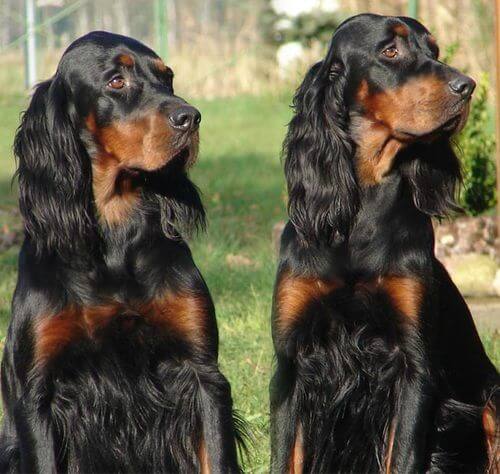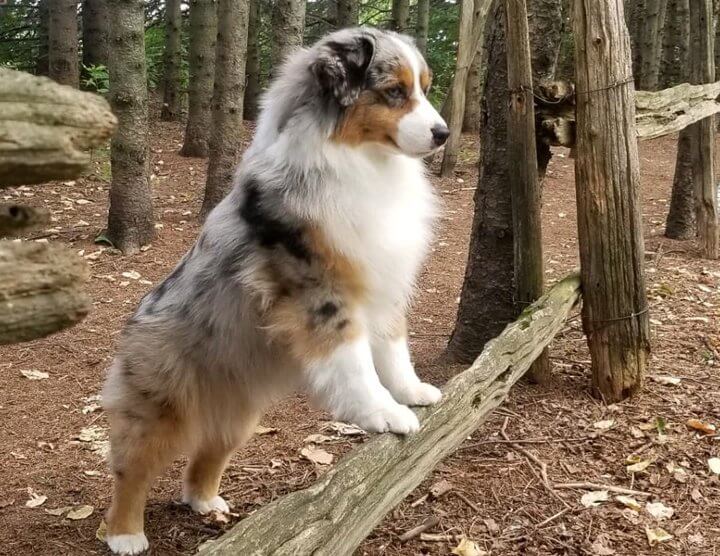Gordon Setter Dog Breed | Description, Temperament, Lifespan, & Facts
The Gordon Setter dog, often recognized by its striking black and tan coat, is a majestic breed with a rich history. Known for its loyalty, intelligence, and energetic nature, the Gordon Setter is a beloved companion for families and hunters alike. This guide delves into the comprehensive details of the Gordon Setter, providing insights into its appearance, temperament, health, care requirements, and more.
Contents
Appearance
The Gordon Setter is a large and sturdy dog breed, known for its elegant and powerful build. This breed typically stands between 23 to 27 inches at the shoulder and weighs between 45 to 80 pounds, with males generally being larger than females.
Physical Characteristics

The breed is characterized by its black coat with distinctive tan markings on the muzzle, legs, chest, and eyebrows. The coat is medium to long, silky, and can be slightly wavy. Regular grooming is essential to maintain the coat’s condition and prevent matting.
Coat and Color Variations
The primary coat color of the Gordon Setter is black with rich mahogany or chestnut markings. This combination gives the breed its unique and regal appearance.
Temperament
The Gordon Setter is known for its affectionate and loyal nature. This breed thrives on companionship and forms strong bonds with its family. They are often described as friendly, intelligent, and eager to please.
Personality Traits
Gordon Setters are energetic and require regular physical and mental stimulation. They are excellent companions for active families and enjoy outdoor activities such as hiking, running, and hunting. Despite their high energy levels, they can also be gentle and calm when properly exercised.
Interaction with Families and Children
Gordon Setters is great with children and can be very protective of their family. They are patient and gentle, making them suitable for families with kids. However, early socialization and training are crucial to ensure they develop good manners and behavior.
Socialization Needs
Early socialization is vital for Gordon Setters to help them develop into well-rounded dogs. Exposure to different people, environments, and other animals will help them grow into confident and well-behaved adults.
Health and Lifespan

Gordon Setters are generally healthy dogs, but like all breeds, they are prone to certain health conditions. Understanding these potential issues can help ensure your Gordon Setter lives a long and healthy life.
Common Health Issues
- Hip Dysplasia: A genetic condition where the hip joint is improperly formed, leading to arthritis and pain.
- Progressive Retinal Atrophy (PRA): A degenerative eye condition that can lead to blindness.
- Hypothyroidism: A disorder of the thyroid gland that can cause various symptoms, including weight gain and lethargy.
- Gastric Dilatation-Volvulus (GDV): Also known as bloat, this life-threatening condition requires immediate veterinary attention.
Lifespan Expectancy
The average lifespan of a Gordon Setter is between 10 to 12 years. They can enjoy a full and active life with proper care, regular veterinary check-ups, and a healthy lifestyle.
Preventative Health Measures
Regular vet visits, a balanced diet, and consistent exercise are crucial for maintaining the health of a Gordon Setter. It is also important to monitor for signs of common health issues and seek prompt medical attention when necessary.
Care Requirements
Gordon Setters are relatively high-maintenance dogs due to their grooming needs and energy levels.
Grooming Needs
Their medium to long coat requires regular brushing to prevent tangles and matting. Bathing should be done as needed, and attention should be given to keeping their ears clean to prevent infections.
Exercise and Activity Levels
Gordon Setters are high-energy dogs that require ample exercise. Daily walks, playtime, and activities that challenge them mentally and physically are essential. They are excellent companions for outdoor adventures and excel in activities such as agility, hunting, and obedience training.
Feeding and Nutrition Tips
A balanced diet tailored to the dog’s age, weight, and activity level is crucial. Because they are prone to bloat, it’s recommended to feed them smaller meals throughout the day rather than one large meal and avoid vigorous exercise around meal times.
Training
Training a Gordon Setter can be a rewarding experience due to their intelligence and eagerness to please.
Trainability
They are quick learners but can be somewhat independent. Positive reinforcement techniques work best, and consistent, patient training will yield the best results.
Tips for Effective Training
- Start training and socialization early.
- Use positive reinforcement methods.
- Be consistent with commands and rules.
- Engage them with varied and interesting training sessions to keep their interest.
Common Behavioral Issues and Solutions
Like many intelligent breeds, Gordon Setters can develop behavioral issues if not properly stimulated. Common issues include chewing, digging, and barking, which can often be mitigated with sufficient exercise and mental stimulation.
Living Conditions
Gordon Setters are adaptable dogs but thrive best in environments where they have ample space to run and play.
Suitable Living Environments
They are well-suited for homes with large yards where they can safely explore and expend their energy. However, they can adapt to apartment living if given enough exercise and outdoor time.
Compatibility with Other Pets
Gordon Setters generally get along well with other pets, especially if they are raised together. Early socialization helps in ensuring harmonious relationships with other animals.
Adaptability to Different Climates
With their dense coat, Gordon Setters are well-suited for cooler climates but can adapt to warmer environments with proper care. It’s important to provide them with plenty of water and shade in hot weather.
History and Origin
The Gordon Setter has a rich history that dates back to the 17th century in Scotland.
Origins and Development of the Breed
Originally bred by the Duke of Gordon, this breed was developed for its hunting abilities, particularly in locating and retrieving game birds. They are part of the setter family, which includes the English Setter and Irish Setter, but are distinguished by their unique coloring and build.
Evolution of the Breed Standard
Over the centuries, the breed has been refined to enhance its hunting skills and physical characteristics. The American Kennel Club (AKC) recognized the Gordon Setter in 1892, and they continue to be valued for their work ethic and companionship.
Role in Hunting and Working Roles
Gordon Setters were primarily used as bird dogs, valued for their keen sense of smell and ability to cover rough terrain. They remain popular among hunters today and excel in various dog sports and activities.
Fun Facts and Trivia
Gordon Setters are full of interesting traits and history that make them a unique and cherished breed.
Unique Characteristics
- Distinctive Tan Markings: The tan markings above their eyes give them a distinctive and expressive appearance.
- Loyal Companions: Known for their strong bond with their families, they are often described as ‘velcro dogs’ due to their tendency to stick close to their owners.
- Versatile Athletes: They excel in various dog sports, including agility, obedience, and field trials.
Famous Gordon Setters
Several notable individuals have owned Gordon Setters, further cementing their place in history and popular culture.
Interesting Historical Tidbits
- Noble Origins: The breed was developed by the 4th Duke of Gordon in Scotland, who was passionate about creating a superior hunting dog.
- American Introduction: Gordon Setters was brought to the United States in the mid-19th century and quickly gained popularity among hunters and dog enthusiasts.
Conclusion
The Gordon Setter is a remarkable breed with a blend of elegance, loyalty, and athleticism. Whether as a hunting companion or a family pet, this breed offers endless joy and companionship to those who can meet its needs. With proper care, training, and attention, a Gordon Setter can be a loving and loyal addition to any home.
- Golden Retriever Pros and Cons: What Every Pet Parent Should Know - 15 September 2025
- Cane Corso Dog Breed: Health, Care, and Lifespan - 14 September 2025
- Catahoula Leopard Dogs: Description, Temperament, Lifespan, & Facts - 21 July 2025







